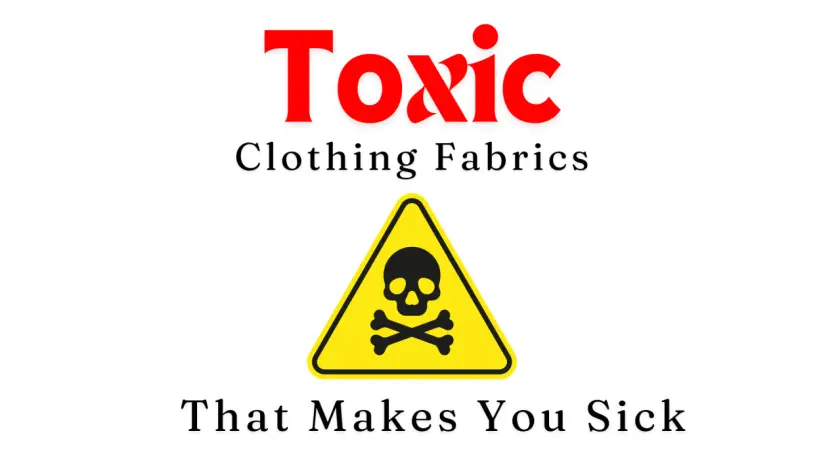Everything is toxic! Everything is toxic! Everything is toxic! Sometimes it feels that way. We live in a world full of toxic chemicals, carcinogens (cancer causing chemicals) and other endocrine disrupting chemicals that damage our hormones. The food we eat, drinks we drink and even some of the supplements that we take are contaminated.
Part of my goal with the education behind Healthy Wild Free is to educate on these toxins, their dangers and provide healthier solutions.
Today we’ll be discussing and gaining understanding around synthetic fibers and fabrics that impact the fashion industry and the clothing we wear.
In a world dominated by fast fashion and synthetic comfort, many of us rarely question the materials our clothes are made from. Yet, what we wear every day may be slowly compromising our health. Fabrics like polyester, acrylic, nylon, and rayon are cheap to produce, easy to care for, and widely used across everything from sportswear to underwear. But beneath the surface of these synthetic staples lies a troubling truth: they can negatively affect your skin, your hormones, your respiratory health, and even your long-term well-being.
Polyester: Plastic on Your Skin
Polyester is one of the most common fabrics on the planet. It’s used in everything from gym clothes to bedding to baby clothing. Made from petroleum-based chemicals, polyester is essentially a form of plastic. When you wear polyester, especially close to the skin, several things happen:
- Lack of Breathability: Polyester traps heat and moisture, creating a warm, damp environment that’s ideal for bacterial and fungal growth. This can lead to skin issues like acne, rashes, or infections, particularly in areas like the groin, armpits, or under the breasts.
- Chemical Leaching: Polyester is often treated with dyes, flame retardants, and anti-wrinkle agents. These chemicals can leach into your skin, especially when your body heat activates them.
- Microplastic Shedding: Each time you wash polyester garments, tiny plastic fibers—called microplastics—are released into the water supply. These microplastics have made their way into oceans, food chains, and even human bloodstreams.
Acrylic: The Imitation Wool with a Toxic Core
Acrylic fabric is used as a cheaper alternative to wool. You’ll find it in sweaters, blankets, and winter wear. Unfortunately, it’s one of the most toxic fibers used in clothing.
- Carcinogenic Chemicals: Acrylic is made from polyacrylonitrile, a substance considered a probable human carcinogen by the EPA. Long-term exposure, even through the skin, may carry risks.
- Skin Sensitivity: Acrylic can cause contact dermatitis and skin irritation, particularly in people with sensitive skin or allergies.
- Off-Gassing: Acrylic can release volatile organic compounds (VOCs) into the air, especially when heated. These compounds are associated with headaches, dizziness, and even long-term neurological effects.
Nylon: The Sweat Trap
Nylon is another petroleum-based synthetic fabric, often found in hosiery, underwear, swimwear, and activewear. It’s strong, stretchy, and smooth to the touch—but that doesn’t make it safe.
- Non-Breathable: Nylon doesn’t allow your skin to breathe. This traps sweat and creates a breeding ground for odor-causing bacteria and yeast.
- Chemical Cocktails: Like polyester, nylon is often treated with multiple chemical agents during production. These can include formaldehyde and perfluorochemicals, both linked to health issues like hormone disruption and cancer.
- Heat Retention: Nylon tends to retain heat, which can worsen skin conditions like eczema, rashes, or general irritation.
Rayon: The Greenwashed Danger
Rayon is marketed as a natural alternative because it’s derived from wood pulp. However, the process to turn wood into soft, wearable fabric is highly chemical-intensive.
- Toxic Processing: The production of rayon involves carbon disulfide, a toxic chemical associated with reproductive issues and neurological damage in workers.
- Residual Chemicals: Though the bulk of chemicals are washed out before rayon reaches the consumer, residues can remain and potentially irritate the skin.
- Environmental Damage: The waste from rayon production often ends up in waterways, posing risks to ecosystems—and ultimately, to human health as toxins make their way back up the food chain.
Why This Matters
Your skin is your body’s largest organ. It’s porous, it absorbs, and it interacts with everything you put on it. If you wear these synthetic fabrics regularly—especially in undergarments or athletic wear where the skin is thinner and sweatier—you’re creating a direct exposure path for toxins and irritants.
Moreover, these fabrics contribute to environmental degradation that loops back into our health: microplastics in our food, chemicals in our water, and polluted air in our homes from off-gassing materials.
What Should You Wear Instead?
The best way to avoid these health hazards is to switch to natural, breathable, and non-toxic fabrics. Organic cotton, hemp, bamboo (mechanically processed), and Tencel are excellent alternatives. But when it comes to underwear—the most intimate item of clothing—it’s even more critical to choose wisely.
Why NADS Underwear is the Best Solution
If you’re serious about ditching synthetic fabrics and protecting your health from the inside out, NADS Underwear is the smartest choice you can make. Made from natural, breathable, and chemical-free materials, NADS is designed to be worn all day without compromising your skin or your comfort. Made without microplastics, toxic dyes, and endocrine-disrupting chemicals
NADS also prioritizes sustainability, using eco-conscious production methods and packaging that aligns with a clean lifestyle. If you’ve had issues with irritation, odor, or just want to feel confident about what’s touching your skin every day, switch to NADS and feel the difference immediately. It’s not just underwear—it’s a long-term investment in your health.
Click here to visit Nads Underwear today. They are very comfortable and you can rest assured that synthetic fibers, fabrics, Microplastics and other cancer causing chemicals wont be leaking into your genitals.





